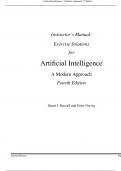Exam (elaborations)
Instructor’s Manual: Exercise Solutions for Artificial Intelligence A Modern Approach Fourth Edition Stuart J. Russell and Peter Norvig
- Course
- Institution
Instructor’s Manual: Exercise Solutions for Artificial Intelligence A Modern Approach Fourth Edition Stuart J. Russell and Peter Norvig
[Show more]



